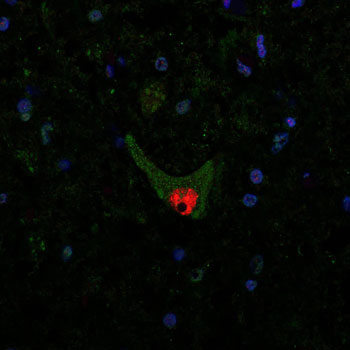Mutant Protein Aggregates Drive Progression of ALS in Mouse Model
By LabMedica International staff writers
Posted on 16 May 2016
Researchers working with a mouse model of amyotrophic lateral sclerosis (ALS) have demonstrated that aggregates of mutated superoxide dismutase 1 (SOD1) can propagate the disease by progressing through nerve cells along the animal's spinal cord.Posted on 16 May 2016
ALS is a specific disorder that involves the death of neurons. The disease, for which there is no cure, is characterized by stiff muscles, muscle twitching, and gradually worsening weakness due to muscles decreasing in size. Most ALS sufferers die from respiratory failure.

Image: Aggregated SOD1 protein can be seen as green dots in the cell fluid of a motor neuron in the spinal cord of an ALS patient. The red area is the nerve cell nucleus (Photo courtesy of Peter Andersen, Umeå University).
It has been shown that at the molecular level ALS was frequently caused by mutations in the gene encoding SOD1. Both patients and Tg mice expressing mutant human SOD1 (hSOD1) developed aggregates of unknown importance. In Tg mice, two different strains of hSOD1 aggregates (denoted A and B) have been identified; however, the role of these aggregates in disease pathogenesis has not been fully characterized.
Investigators at Umeå University (Sweden) prepared A and B hSOD1 strain aggregates by centrifugation through a density cushion. They then inoculated minute seeds of these substances into the lumbar spinal cords of 100-day-old mice carrying a human SOD1 Tg mutation.
Results published in the May 3, 2016, online edition of the Journal of Clinical Investigation revealed that mice seeded with A or B aggregates developed premature signs of ALS and became terminally ill after approximately 100 days, which was 200 days earlier than for mice that had not been inoculated or were given a control preparation. At the same time, exponentially growing strain A and B hSOD1 aggregations propagated throughout the spinal cord and brainstem, which resulted in the eventual death of the mice.
"The occurrence of SOD1 aggregates in nerve cells in ALS patients has been known for a while," said senior author Dr. Thomas Brännström, professor of pathology at Umeå University. "But it has long been unclear what role the SOD1 aggregates play in the disease progression in humans carrying hereditary traits for ALS. We have now been able to show that the SOD1 aggregates start a domino effect that rapidly spreads the disease up through the spinal cord of mice. We suspect that this could be the case for humans as well."
Related Links:
Umeå University













